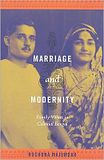Marriage and Modernity
Majumdar, Rochona:
Marriage and modernity : family values in colonial Bengal / Rochona Majumdar. - Durham : Duke University Press, 2009. - XII, 343 S. : Ill.
ISBN 978-0-8223-4462-9 / 0-8223-4462-9 (Hardcover)
US$ 84,95
ISBN 978-0-8223-4478-0 / 0-8223-4478-5 (Paperback)
US$ 23,95
DDC: 306.810954/1409034
Beschreibung
An innovative cultural history of the evolution of modern marriage practices in Bengal, Marriage and Modernity challenges the assumption that arranged marriage is an antiquated practice. Rochona Majumdar demonstrates that in the late colonial period Bengali marriage practices underwent changes that led to a valorization of the larger, intergenerational family as a revered, “ancient” social institution, with arranged marriage as the apotheosis of an “Indian” tradition. She meticulously documents the ways that these newly embraced “traditions”—the extended family and arranged marriage—entered into competition and conversation with other emerging forms of kinship such as the modern unit of the couple, with both models participating promiscuously in the new “marketplace” for marriages, where matrimonial advertisements in the print media and the payment of dowry played central roles. Majumdar argues that together the kinship structures newly asserted as distinctively Indian and the emergence of the marriage market constituted what was and still is modern about marriages in India.
Majumdar examines three broad developments related to the modernity of arranged marriage: the growth of a marriage market, concomitant debates about consumption and vulgarity in the conduct of weddings, and the legal regulation of family property and marriages. Drawing on matrimonial advertisements, wedding invitations, poems, photographs, legal debates, and a vast periodical literature, she shows that the modernization of families does not necessarily imply a transition from extended kinship to nuclear family structures, or from matrimonial agreements negotiated between families to marriage contracts between individuals. Colonial Bengal tells a very different story. [Verlagsinformation]
Inhalt
Acknowledgments. ix
Introduction. 1
PART I: THE EMERGENCE OF A MARRIAGE MARKET
1. Looking for Brides and Grooms. 23
2. Snehalata's Death: Questions of Dowry. 54
PART II: CULTURE AND THE MARKETPLACE
3. Marriage and Distinction: New Critiques of Vulgarity. 93
4. The Not-Quite Bourgeois: The Couple Form and the Joint Family. 126
PART III: MARRIAGE AND THE LAW
5. A Nineteenth-Century Debate: Law versus Rituals. 167
6. Nationalizing the Joint Family: The Hindu Code Debates, 1955-56. 206
Conclusion. 238
APPENDICES
1. Wedding Invitations. 244
2. Jewelry Catalogues. 253
Notes. 259
Glossary. 301
Bibliography. 311
Index. 337
Autorin
ROCHONA MAJUMDAR is Assistant Professor of South Asian Languages and Civilizations at the University of Chicago. She is a co-editor of From the Colonial to the Postcolonial: India and Pakistan in Transition. Faculty profile.
Quellen: Duke University Press; WorldCat; Amazon; Barnes & Noble; Library of Congress.
Ähnlich
- Viswanath: The Pariah Problem
- Lal: Coming of Age in Nineteenth-Century India
- LaDousa: Hindi is Our Ground, English is Our Sky
- Titzmann: Der indische Online-Heiratsmarkt
- Migration and Religion in Europe
- Swank: Rewriting Shangri-La
- Newbigin: The Hindu Family and the Emergence of Modern India
- Kroll: Gesundheitliche Disparitäten im urbanen Indien
- The Jews of Andhra Pradesh
- Van Hollen: Birth in the Age of AIDS

